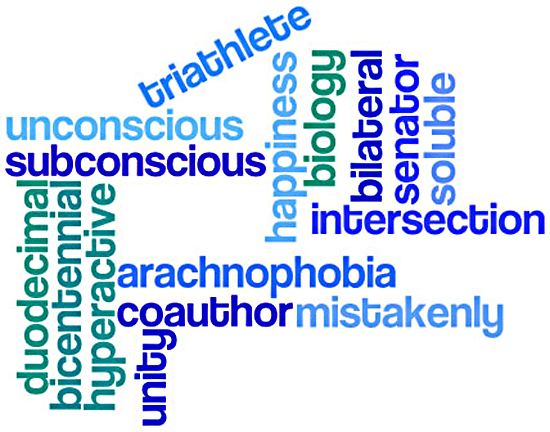Introduction

In this lesson, you are going to learn about parts of words and their meanings. Understanding them can help you become a better reader by increasing your vocabulary and your fluency. You probably know from previous lessons that words are composed of elements such as root words. For example, if we begin with a simple word such as happy and add the prefix “un” in front of it, happy becomes unhappy and takes on the opposite meaning.
When we talk about adding prefixes or suffixes to words, we use the word “affix” to signify that an element has been added either to the beginning or the ending of a word. There are many prefixes in English; yet only 20 account for 97% of the words that contain prefixes. Learning these 20 prefixes and their meanings can make a big difference in your ability to recognize words and their meanings.
Suffixes are a bit more challenging because many times the ending added to a word makes it a different part of speech, a different tense, or even a different number—think about how many times you add -s or -es to words. Knowing that a word may have a suffix that changes the meaning is helpful as you continue to improve your reading skills.
When you break a word apart and remove the prefixes and suffixes, you are left with the root. It’s easier to determine the meaning of an unknown word if you know the root. For example, you might be familiar with the word navigate when you help your mom or dad with directions, but you might not be sure about the meaning of the word circumnavigate until you learn that the prefix circum- means “around.” Now when you read about early explorers who circumnavigated the globe, you know that it means they went “around” the world. Many times the root is a Latin or Greek word that’s unfamiliar, and it’s harder to break the word apart completely because we are unfamiliar with the affixes and unsure of the root.
Supercilious, for example, is difficult because after you take all the affixes away, you’re left with “cilia,” a Latin root that means “the edge of the eyes or the eyelashes.” Knowing this root doesn’t help illuminate the meaning of supercilious, which means “haughty or pretentious,” but it can provide enough information, so that in certain testing situations and in context, we might be able to discover the meaning of this word. The origin actually has to do with a person’s nose being in the air, higher than their eyelashes! Like anything else in school, if you practice taking words apart to find their meanings, you will be rewarded with a richer vocabulary and an ability to read more fluently.

Many affixes began as part of a language called Latin. The following are examples of Latin affixes:
- super-, meaning “above” or “over” (i.e., supercede)
- trans-, meaning “across” (i.e., transform)
- de-, meaning “down” (i.e., denote)
- -ify, meaning “make” or “cause to become” (i.e., modify)
Other affixes come from Greek such as the following:
- anti-, meaning “against” (i.e., antithesis)
- -sis, meaning “process” or “action” (i.e., analysis)
- ex-, meaning “out of” (i.e., excommunicate)
Knowing whether affixes are from Latin or Greek is not as important as knowing the definitions of as many affixes as possible. This knowledge will give you a strategy for finding the meaning of longer, multisyllabic words. (Can you spot the affixes in multisyllabic?)

Think about the following questions:
- What do I know about prefixes and suffixes?
- How do I spot an affix while reading?
- How can knowing affixes help me understand a word I don’t know?
- How can I use this knowledge in math, science, and history classes?
Knowing the meaning of an affix when you come across it in your reading can help you understand an unknown word by breaking it into smaller parts. This strategy will allow you to expand your vocabulary so that you can read challenging material with confidence. Your knowledge of affixes will help you in history, science, math, and English classes.
Think about how units in math may have similar beginnings or endings to provide a clue about measurements (i.e., the prefix kilo- in the word kilometer). In science, a suffix is used to change a subject to “the study of” something (i.e., the suffix -logy in biology or ecology). In history, a suffix might tell you about the time period you are studying (i.e., the suffix -n in the Elizabethan or Victorian Age). Affixes are a part of every subject, and knowing them can help you comprehend more in your courses.
Download and open the graphic organizer. You can type your answers on-screen or print this file and write them. When you are finished with the graphic organizer, go to the next section in this lesson. Graphic Organizer Instructions
Images used in this section
Source: Dictionary definition of “Communication” close up. MS Office. Source: Root Cutter, Auntie P, flickr Source: Word cloud, IPSI
Learning Affixes
Prefixes
As you have learned, a prefix comes before a root word. For example, a prefix is used to make the word transport. Trans- means “across” and port means to carry. Trans- is the prefix and port is the root word. Adding the prefix to the root word creates transport and changes the meaning of port to “carry across from place to place.”
|
trans + port = transport (Latin) |
||
|---|---|---|
|
trans- = “across” |
port = “to carry” |
transport = “to carry across from place to place” |
The following is a list of the 20 most frequently used prefixes. Being familiar with these will help you as you work to increase your vocabulary and reading skills.
| 1. un- = not | 11. pre- = before |
| 2. re- = again | 12. inter- = between |
| 3. in-, im-, il-, ir- = not | 13. fore- = front or before |
| 4. dis- = away, not | 14. de- = down |
| 5. en-, em- = to make into, to put into | 15. trans- = across |
| 6. non- = not | 16. super- = above |
| 7. in-, im- = in | 17. semi- = half, partly |
| 8. over- = above | 18. anti- = against |
| 9. mis- = wrong | 19. mid- = half |
| 10. sub- = under | 20. under- = under |
Source: www.cdl.org
Let's look at some other prefixes.
|
mono + tone = monotone (Greek) |
||
|---|---|---|
|
mono- = “one” |
tone = “sound, color, style” |
monotone = “sameness, dullness, repetition in sound, color , style, or manner” |
|
contra + dict = contradict (Latin) |
||
|---|---|---|
|
contra- = “against” |
dict = “to say or speak” |
contradict = “to speak against ” |
|
inter + ject = interject (Latin) |
||
|---|---|---|
|
inter- = “between, among” |
ject = “to throw” |
Interject = “to throw in, interrupt” |
Suffixes
A suffix comes after a root word. A suffix is used to make the word laughable. The suffix -able means “able to or capable of” and laugh is the root word. So laughable means “able to laugh or capable of a laugh.” Adding the suffix -able modifies the meaning of the word.
The following is a list of the 20 most frequent suffixes. You’ll see that suffixes are more complicated than prefixes and often determine a part of speech. Familiarizing yourself with these will help improve your reading skills.
| 1. -s, -es = plural | 11. -ity, -ty = act, state, quality |
| 2. -ed = past tense | 12. -ment = action or process |
| 3. -ing = ongoing | 13. -ic = pertaining to |
| 4. -ly = degree | 14. -ous, -eous, -ious = full of |
| 5. -er, -or = one who | 15. -en = to become or made of |
| 6. -in, -tion, -ation,-ition = action | 16. -er = comparative |
| 7. -able, -ible = able to be | 17. -ive, -ative, -tive = quality of, that which, causing |
| 8. -al, -ial = relating to pertaining to | 18. -ful = full of |
| 9. -y = characterized by | 19. -less = unable to |
| 10. -ness = a state of being | 20. -est = superlative |
Let's look at some other suffixes.
|
cred + ible = credible (Latin) |
||
|---|---|---|
|
-ible = “able to or capable of ” |
cred = “believe” |
credible = “able to believe” |
|
hydro + phobia = hydrophobia (Latin) |
||
|---|---|---|
|
-phobia = “fear of” |
hydro = “water” |
hydrophobia = “intense fear of water” |
Take a minute and study the prefixes and suffixes and their meanings and then complete the activity below to test your knowledge. Click and drag each prefix or suffix below from the box on the left to the oval next to its meaning. For example, click and drag the prefix trans-, which means “across or because” into the first oval below.
Now, using the your notes, make a list of five affixes you use frequently. Think about sports or hobbies that interest you, assignments or classes pertaining to your school work, or tasks and responsibilities related to a job. What words containing affixes do you use most often? (No answers are provided since answers will vary.)
Example: I play soccer; I’m skillful with the ball.
List five affixes that you use weekly:
Identifying Affixes

Now that you know the two parts of language that can create an affix, let’s see if you can find them while you read a passage from A Princess of Mars by Edgar Rice Burroughs. First, skim the passage to see if you can find affixes and then read the passage to see if you guessed the right meaning. The following is a reading strategy to try if you come across a word that you don’t know:
- Read the rest of the words in the sentence.
- Look for any parts of the word you recognize such as the prefix or suffix.
- Divide the stem into chunks that you can pronounce to see if the word sounds familiar and ask yourself if the word makes sense with the rest of the sentence.
After reading through the passage once, go back and click on the affixes that you find. If you choose correctly, the words will highlight. Hint: there are 12 affixes.
Now that you know what affixes are present in the passage, check your understanding of the words. Keep the context of the paragraph in mind. Respond to each question below by checking the correct box. The first question contains a hint to help get you started. You may use a dictionary to find the meaning of the prefix or suffix if it is unfamiliar.
Images used in this section
Source: Eye Spy, KayVee.INC, Flickr
Using Affixes to Help You Read
So far, you have reviewed your knowledge of prefixes, root words, and suffixes. You also identified affixes, searched for affixes while reading, and thought about how the meanings of words change when an affix is added. Now you’re ready to take your knowledge of affixes to the next level. You will learn more Latin and Greek meanings to help you further understand how words change when something is added.
You already learned a few Greek and Latin words at the beginning of the lesson; let's see if you remember them. Click and drag each meaning to the correct affix.
Now let’s see if you can figure out the meaning of some affixes and how they might be used. In the activity that follows, click on each affix to drag and drop it next to the correct meaning. Use a dictionary to look up unfamiliar affixes.
See if you can spot the two affixes in the sentence below.
A knowledge of affixes can be very helpful when reading assignments for an English class. For example, knowing that the suffix -ly (i.e., truly, madly, and deeply) changes the degree of an adjective is valuable because this information can give you a deeper understanding of what you read.
Learning affixes can help you in other classes as well. For example, you might see the words courageously and forcefully being used in a history book to describe the actions of soldiers in battle. Think about how the affixes you have learned might help you in other classes too.
What kind of prefixes do you think occur in math? Maybe a prefix will provide a clue to a unit of measurement (i.e., kilo- meaning “1,000”). What kind of prefixes or suffixes do you think occur in science? Suffixes such as -logy or -phobic can tell you that an unfamiliar word means “the study of something” or “the fear of something.” To see more examples of affixes that provide clues about the meanings of math, science, and history terms, study the chart below.
|
Affixes |
Courses |
|---|---|
| poly- = many (polynomial) | Math |
| anti- = against, opposite (antigravity) | Science |
| bi- = two (bicentennial) | History |
| centi- = hundredth (centimeter) | Math |
| -or = a person who (senator) | History |
| -cycle = circle, wheel (recycle) | Science |
| -logy = study of (biology) | Science |
For the next exercise you will use a graphic organizer. Click the link to download and open the graphic organizer and type your responses on-screen or print the file and write them. When you're finished with the graphic organizer, go to the next section in this lesson. Graphic Organizer Instructions
Your Turn
As a final activity, spend some time learning how to use your knowledge of affixes in a challenging situation, such as when you are assigned a difficult passage to read.
You should be able to
- recognize a prefix;
- recognize a suffix;
- recognize a root word;
- understand how an affix can change the meaning of a word; and
- apply your knowledge of prefixes and suffixes to help you comprehend an unfamiliar word.

Hints: Make sure you return to the passage and use the context to assist you in determining the meaning of an unknown word. Watch out for definitions that aren’t supported by context.
Read the following passage from Great Expectations by Charles Dickens. In this section of the novel, young Pip has been sent away from his home to Miss Havisham, a grim old woman in town. He has spent the night at the home of his Uncle Pumblechook where they are having breakfast. The passage may be difficult to understand at first, but we’ll go through it together to help you better understand what you read.
1) Mr. Pumblechook and I breakfasted at eight o’clock in the parlour behind the shop, while the shopman took his mug of tea and hunch of bread-and-butter on a sack of peas in the front premises. (2) I considered Mr. Pumblechook wretched company. (3) Besides being possessed by my sister’s idea that a mortifying and penitential character ought to be imparted to my diet - besides giving me as much crumb as possible in combination with as little butter, and putting such a quantity of warm water into my milk that it would have been more candid to have left the milk out altogether - his conversation consisted of nothing but arithmetic.
(4) On my politely bidding him Good morning, he said, pompously, “Seven times nine, boy?” (5) And how should I be able to answer, dodged in that way, in a strange place, on an empty stomach! (6) I was hungry, but before I had swallowed a morsel, he began a running sum that lasted all through the breakfast. (7) “Seven?” (8) “And four?” (9) “And eight?” (10) “And six?” (11) “And two?” (12) “And ten?” (13) And so on. (14) And after each figure was disposed of, it was as much as I could do to get a bite or a sup, before the next came; while he sat at his ease guessing nothing, and eating bacon and hot roll, in (if I may be allowed the expression) a gorging and gormandising manner.
Let’s think about what we know about the first line: We know what the shopman had for breakfast, and we know from the second sentence that the narrator has an opinion of Mr. Pumblechook, but we might not know what “wretched” means, so we’ll come back to that word.
The third sentence is a real doozy, so our discussion is going to be a doozy also. Be patient. Aside from being long, the sentence has several difficult words. The good thing is that you might be able to use your knowledge of affixes and roots to discover the meanings. The first part of the sentence seems to be a discussion of the narrator’s diet, but what do those words mean? We know that “mort” has to with mortal or the idea that we die. So then mortifying must be negative—very negative—if it has “mort” in it.

Notice that mortifying also contains two suffixes, -ify and -ing. We said that -ify means to “make or cause to become.” You probably know that -ing is related to an action or process, so you could interpret mortifying as “an action causing death.” If you read on, you may not exactly know the definition of mortifying, but you will see that it’s used in relation to Pumblechook’s diet. You know it’s not the kind of breakfast you would like to eat!
Now let’s look at penitential. What do we know about the root? Think of penitentiary, penance, penitent? These words have to do with punishment. So that’s another negative word that is used to describe the uncle’s diet and breakfast. Hold onto those thoughts while you think about the word impart. The prefix “im-” means “in” and “part” is an easy word. To part with something means “to give it away.” So impart is “giving something away,” but what’s being given away here? Read it again; you’ll see that the other negative words are describing his diet and his breakfast. Now what do you think the narrator thinks of Pumblechook? Can you guess what wretched might mean?
The rest of the excerpt may be easier to understand, but look at the last line. Can you guess from the context what gorging and gourmandizing might mean? Again, notice the -ing suffixes. What is Pumblechook doing? He’s eating rolls and bacon while the narrator drinks watered down milk and has a small bit of bread, so perhaps we can make a guess that gorging and gourmandizing have to do with eating good food.
This may seem like a great deal of work, but if you do this every time you read a difficult passage, it will get easier. Plus you will increase your vocabulary and your comprehension.
Now see if you can answer a few questions.
In the third sentence, mortifying means—
- to make somebody feel deeply ashamed and humiliated.
- to kill someone.
- to heighten somebody’s intellectual, moral, or spiritual awareness.
Let’s look at each choice. If you choose the first answer, do you think Mr. Pumblechook wants to make the narrator feel ashamed or humiliated? Mr. Pumblechook didn’t give him much food: “. . . giving me as much crumb as possible . . . with as little butter . . .” So this might be a possible answer.
Let’s look at the second choice. Do you think Mr. Pumblechook wants to kill the narrator? Mr. Pumblechook seems mean, but maybe not to the extent of wanting to kill Pip. He is also spending time teaching the narrator math, so he’s investing time and energy into the narrator. This is probably not the best answer.
What if you choose “c”? Do you think Mr. Pumblechook wants to heighten the narrator’s intellectual, moral, or spiritual awareness? Mr. Pumblechook doesn’t treat him like he cares very deeply, but he is teaching him math. The narrator does not like the situation very much, so this might not be a good answer either.
Based on the choices and how they are used in the context of the passage, the first one seems like the best possible answer.
Now try some questions on your own.
Now that you’ve seen how easy it is to find the meaning of unfamiliar words by breaking them apart, you might want to visit the website “Building a Better Vocabulary” to continue your study of affixes. Once you are on the website, scroll to the bottom of the page. There you will find quizzes to help you gain more knowledge about words and become a better reader.
Images used in this section
Source: Charles Dickens by Don, flickr, garryknight Source: Stoneground Bread & Butter, Brett Jordan, flickr Source: tower est mort, h-monk, flickr
Resources
“Building a Better Vocabulary.” The Guide to Grammar and Writing. //grammar.ccc.commnet.edu/grammar/vocabulary.htm.
Burroughs, Edgar Rice. A Princess of Mars. Project Gutenberg. 2008. //www.gutenberg.org/files/62/62-h/62-h.htm.
Carroll, John B., Peter Davies, and Barry Richman. “Top 20 Prefixes.” The American Heritage Word Frequency Book. Boston: Houghton Mifflin, 1971.
Dickens, Charles. Great Expectations. Project Gutenberg. 2008. //www.gutenberg.org/files/1400/1400-h/1400-h.htm.
“Vocabulary exercises.” TV411. The Adult Literacy Media Alliance, 2000–2010. //www.tv411.org/vocabulary/.
